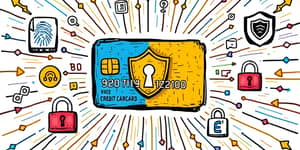
Opening your first credit card is a defining financial milestone. Establishing responsible habits early can shape your future for decades. This guide will walk you through each decision point, armed with expert insights and the latest data.
Your first credit card establishes your record with lenders and credit bureaus. It represents your first opportunity to demonstrate reliability, punctuality, and fiscal responsibility.
On-time payments account for 35% of most scoring models, showing creditors you can manage debt. With a solid track record, you gain access to better loan offers and long-term impact on your borrowing ability.
Conversely, late or missed payments can remain on your report for up to seven years, affecting interest rates and approval odds. Early missteps can be costly, so understanding the stakes is crucial.
A credit card functions as a revolving line of credit, allowing purchases up to your limit and requiring a minimum monthly payment. Balances not paid in full accrue interest, typically calculated on the average daily balance.
During grace periods—usually 21–25 days—no interest applies if you pay your statement balance in full by the due date. Failing to clear the balance before the cycle ends results in interest charges at the card’s APR.
APR stands for Annual Percentage Rate. Introductory offers may include 0% promo APRs for 12–18 months, reverting to a standard rate of 19.49%–28.24% afterward. Compare both rates to avoid unexpected costs.
Fees can include annual fees, late payment fees, balance transfer fees, foreign transaction fees, and over-limit fees. Read the issuer’s fee schedule to understand potential charges before applying.
Your credit score ranges from 300 to 850. A score above 690 unlocks premium cards, but first-timers often start with limited or no history. Begin by pulling your free annual credit report from Experian, Equifax, and TransUnion.
Score composition typically breaks down as follows: payment history (35%), credit utilization (30%), account age (15%), new credit (10%), and credit mix (10%). Knowing these factors helps you target improvement strategies.
If your score is below 630, secured, student, or starter cards are often more accessible. A secured card requires a refundable deposit—often $200 or more—which sets your credit limit and offers a pathway to approval.
Selecting the right card type depends on your credit access and goals. Below is a breakdown of the main options available to first-time applicants:
Most first-time applicants find secured cards or student cards the easiest path, building a record that can qualify them for better products later.
When comparing your options, the annual fee versus benefits is paramount. Many entry-level cards charge $0, while some low-fee products justify a modest fee with additional perks such as purchase protections or travel insurance.
Promotional APRs, often 0% for 12–18 months, can ease financing needs, but be sure you understand the standard APR that kicks in afterward—typically between 19.49% and 28.24%. Always read the fine print to avoid surprises.
Reward structures vary from flat-rate cash back—often 1.5%—to category-based bonuses offering up to 5% on groceries or gas. Choose a rewards model that aligns with your spending habits.
Confirm the issuer’s monthly reporting to all major bureaus to ensure timely credit-building. Finally, review fee schedules for foreign transactions, late payments, and balance transfers to gauge the true cost of carrying the card.
Applying for your first card is straightforward. Most issuers allow you to complete the entire process online in under ten minutes. Follow these steps:
1. Verify you meet the minimum age requirement (18+). 2. Gather your Social Security number, proof of income, and address. 3. Use pre-qualification tools to gauge approval odds without affecting your score. 4. Submit the application, triggering a hard inquiry that may lower your score by a few points.
Upon approval, you will typically receive your card within 7–10 business days. Activate it via phone or online portal, set up an account dashboard, and consider enrolling in autopay or payment reminders to maintain punctual payments.
Setting up alerts and automatic payments can help you stay on track and prevent oversight, which is crucial in the early months of credit building.
Learn from these common errors to protect your credit record and maintain financial stability as your use of credit expands.
Several issuers have designed cards specifically for newcomers to the credit world. Consider these top picks:
Capital One Quicksilver: $0 annual fee, unlimited 1.5% cash back, and no foreign transaction fees. Great for everyday spending.
Chase Freedom Unlimited®: Offers 1.5% cash back on all purchases, a 0% intro APR for 15 months, and strong bonus categories. Regular APR ranges from 19.49% to 28.24%.
Navy Federal cashRewards Secured Card: Combines secured card accessibility with cash back rewards and a streamlined upgrade path after consistent on-time payments.
Discover it Student Chrome: Awards 2% cash back on gas and dining up to $1,000 per quarter. Discover matches all cash back earned in the first year.
A well-managed first card can be the bedrock of your credit profile. As your on-time payments accumulate, your score will reflect improved reliability. Over time, older accounts contribute positively to your credit mix and average account age, two key scoring factors.
Once you have 6–12 months of positive history, consider requesting a credit limit increase or a product change. It is often strategic to upgrade rather than opening new accounts, preserving account longevity and minimizing new inquiries.
Regular reviews of your credit report allow you to spot inaccuracies or areas for improvement, helping you refine your approach before seeking premium cards or loans.
Your first credit card is more than a plastic card—it is a key that unlocks future financial opportunities. By understanding key terms, choosing the right product, and adopting disciplined habits, you can build a credit history that supports home ownership, low-interest loans, and more. Take each step thoughtfully, use the tools and resources at your disposal, and embark on a journey toward lasting financial health.
References













